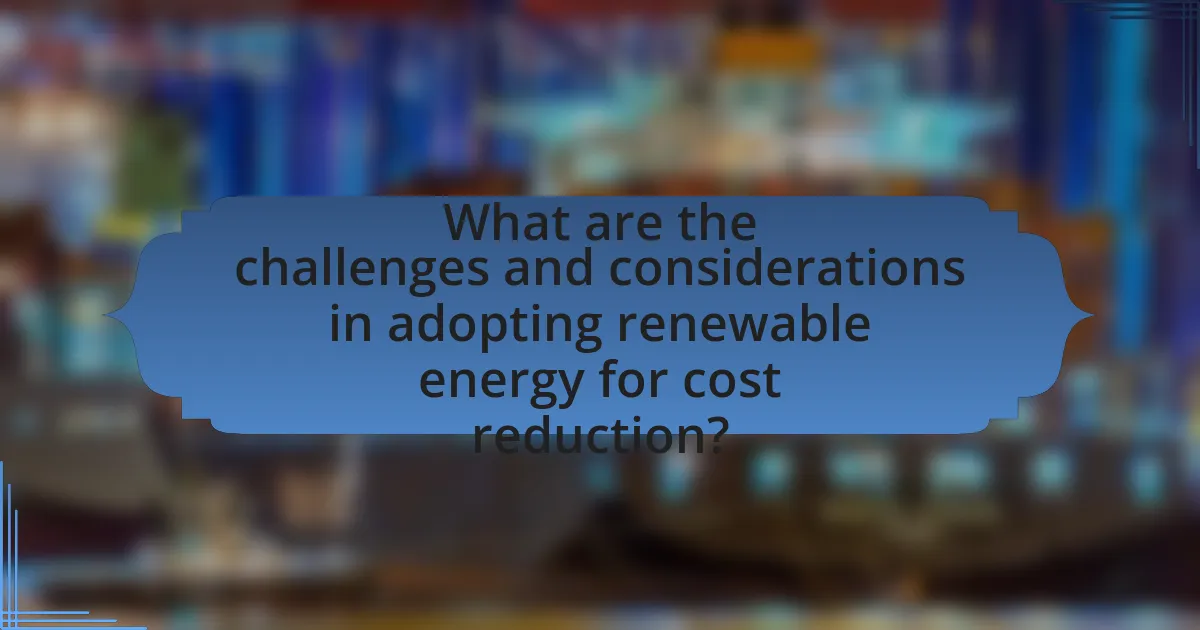Renewable energy is a vital component in reducing operational costs for businesses by providing sustainable and often more affordable energy sources compared to fossil fuels. The article explores how investments in solar and wind energy can lead to significant savings on energy bills, lower maintenance costs, and increased energy independence. It highlights the mechanisms through which renewable energy contributes to cost reductions, including decreased operational expenses, technological advancements, and economies of scale. Additionally, the article discusses the importance of reducing operational costs for enhancing profitability and competitiveness, while also addressing the challenges businesses face in adopting renewable energy solutions. Key metrics for measuring the effectiveness of renewable energy in cost savings are also outlined, along with best practices for maximizing financial benefits.
What is the Role of Renewable Energy in Reducing Operational Costs?

Renewable energy plays a crucial role in reducing operational costs by providing a sustainable and often cheaper source of energy compared to fossil fuels. Organizations that invest in renewable energy sources, such as solar or wind, can significantly lower their energy bills, as these resources typically have lower ongoing costs once the initial investment is made. For instance, a study by the International Renewable Energy Agency (IRENA) found that the cost of solar photovoltaic (PV) electricity has dropped by 82% since 2010, making it one of the most cost-effective energy sources available. Additionally, renewable energy systems can lead to reduced maintenance costs and increased energy independence, further contributing to lower operational expenses.
How does renewable energy contribute to cost savings?
Renewable energy contributes to cost savings by reducing reliance on fossil fuels, which are subject to volatile prices. The use of solar, wind, and hydroelectric power leads to lower operational costs over time, as these energy sources have minimal ongoing fuel costs compared to traditional energy sources. For instance, the U.S. Energy Information Administration reported that the levelized cost of electricity from solar and wind has decreased by 88% and 70%, respectively, since 2009, making them increasingly cost-competitive. Additionally, renewable energy systems often require less maintenance and have longer lifespans, further enhancing their cost-effectiveness.
What are the primary mechanisms through which renewable energy reduces costs?
Renewable energy reduces costs primarily through decreased operational expenses, technological advancements, and economies of scale. Decreased operational expenses arise because renewable energy sources, such as solar and wind, have minimal fuel costs compared to fossil fuels, which are subject to price volatility. Technological advancements, including improved efficiency in solar panels and wind turbines, have led to lower installation and maintenance costs. Economies of scale occur as the renewable energy sector grows, resulting in reduced costs per unit of energy generated; for instance, the cost of solar energy has dropped by over 80% since 2010, according to the International Renewable Energy Agency. These mechanisms collectively contribute to making renewable energy a more cost-effective option in the energy market.
How do operational efficiencies play a role in cost reduction?
Operational efficiencies significantly contribute to cost reduction by streamlining processes and minimizing waste. When organizations enhance their operational efficiencies, they often achieve faster production cycles, reduced labor costs, and lower material expenses. For instance, a study by McKinsey & Company found that companies implementing lean manufacturing principles can reduce operational costs by 20% to 30% through improved efficiency and waste reduction. This demonstrates that operational efficiencies not only lower costs but also enhance overall productivity, leading to sustainable financial benefits.
Why is reducing operational costs important for businesses?
Reducing operational costs is crucial for businesses as it directly enhances profitability and competitiveness. By minimizing expenses, companies can allocate resources more efficiently, invest in growth opportunities, and improve overall financial health. For instance, a study by McKinsey & Company found that companies that actively manage their operational costs can increase their profit margins by up to 20%. This financial flexibility allows businesses to adapt to market changes and invest in innovative solutions, such as renewable energy, which can further reduce costs and promote sustainability.
What impact do operational costs have on overall profitability?
Operational costs significantly affect overall profitability by directly reducing the net income of a business. When operational costs are high, they consume a larger portion of revenue, leaving less available for profit. For instance, a study by the International Renewable Energy Agency found that companies adopting renewable energy solutions can reduce operational costs by up to 30%, thereby enhancing their profitability. This reduction in costs allows businesses to allocate more resources towards growth and investment, ultimately leading to improved financial performance.
How can businesses leverage cost reductions for competitive advantage?
Businesses can leverage cost reductions for competitive advantage by adopting renewable energy sources, which significantly lower operational expenses. By investing in solar, wind, or other renewable technologies, companies can reduce their reliance on fossil fuels, leading to lower energy bills and enhanced sustainability. For instance, a study by the International Renewable Energy Agency found that the levelized cost of electricity from solar photovoltaics has dropped by 89% since 2009, allowing businesses to save on energy costs while also appealing to environmentally conscious consumers. This strategic shift not only improves profit margins but also positions businesses favorably in a market increasingly focused on sustainability and corporate responsibility.
What types of renewable energy sources are most effective for cost reduction?

Solar energy and wind energy are the most effective renewable energy sources for cost reduction. Solar energy has seen a dramatic decrease in costs, with the levelized cost of electricity (LCOE) dropping by 89% from 2009 to 2020, making it one of the cheapest sources of new electricity globally. Wind energy also offers significant savings, with its LCOE falling by 70% in the same period. These reductions in costs are primarily due to advancements in technology, economies of scale, and increased competition in the energy market, leading to lower operational expenses for businesses and consumers alike.
How does solar energy contribute to lowering operational costs?
Solar energy significantly lowers operational costs by reducing electricity expenses. Businesses that install solar panels can generate their own electricity, which decreases reliance on grid power and mitigates energy bills. According to the Solar Energy Industries Association, commercial solar installations can save businesses up to 75% on their electricity costs over time. Additionally, solar energy systems often qualify for tax incentives and rebates, further decreasing initial investment and operational expenses. This combination of reduced energy costs and financial incentives makes solar energy a cost-effective solution for operational efficiency.
What are the initial investment and long-term savings associated with solar energy?
The initial investment for solar energy systems typically ranges from $15,000 to $30,000 for residential installations, depending on system size and location. This upfront cost is often offset by long-term savings on electricity bills, which can amount to $10,000 to $30,000 over 20 years, depending on energy usage and local electricity rates. Additionally, solar energy systems can increase property value and may qualify for tax incentives, further enhancing financial benefits. According to the U.S. Department of Energy, homeowners can save an average of $1,500 annually on energy costs after installation, demonstrating the economic viability of solar energy as a sustainable investment.
How does solar energy impact energy independence for businesses?
Solar energy significantly enhances energy independence for businesses by allowing them to generate their own electricity, reducing reliance on external energy sources. This self-sufficiency leads to lower energy costs and mitigates the risks associated with fluctuating energy prices. According to the U.S. Department of Energy, businesses that adopt solar energy can save an average of 75% on their electricity bills over time, which directly contributes to operational cost reduction. Furthermore, by investing in solar technology, businesses can insulate themselves from energy supply disruptions and price volatility, thereby strengthening their overall financial stability.
What role does wind energy play in operational cost reduction?
Wind energy significantly reduces operational costs by providing a low-cost source of electricity. The levelized cost of energy (LCOE) for onshore wind has decreased by approximately 70% since 2009, making it one of the most economical energy sources available. This reduction in cost is primarily due to advancements in technology, increased efficiency of wind turbines, and economies of scale in manufacturing and installation. Additionally, wind energy has minimal fuel costs, as it relies on a renewable resource, which further contributes to lower operational expenses over time.
What are the cost benefits of implementing wind energy solutions?
Implementing wind energy solutions significantly reduces operational costs through lower energy prices and decreased reliance on fossil fuels. Wind energy has one of the lowest costs of electricity generation, with the U.S. Department of Energy reporting that the levelized cost of energy from onshore wind has fallen by 70% since 2009, making it competitive with or cheaper than traditional energy sources. Additionally, wind energy systems have low maintenance costs, as they typically require less frequent repairs and have longer lifespans compared to conventional power plants. This combination of low generation costs and reduced maintenance expenses leads to substantial savings for businesses and consumers alike.
How does wind energy compare to traditional energy sources in terms of costs?
Wind energy is generally more cost-effective than traditional energy sources, particularly fossil fuels. The levelized cost of electricity (LCOE) for onshore wind has decreased significantly, averaging around $30 to $60 per megawatt-hour, compared to $40 to $100 for coal and natural gas. This reduction in costs is attributed to advancements in technology, economies of scale, and increased competition in the energy market. According to the International Renewable Energy Agency (IRENA), the cost of onshore wind energy has fallen by 49% since 2010, making it one of the cheapest sources of new electricity generation globally.
What are the challenges and considerations in adopting renewable energy for cost reduction?

Adopting renewable energy for cost reduction presents challenges such as high initial investment, technology integration, and regulatory hurdles. High upfront costs for solar panels, wind turbines, and other renewable technologies can deter businesses from transitioning, despite long-term savings. Additionally, integrating renewable energy systems with existing infrastructure requires technical expertise and can lead to increased operational complexity. Regulatory frameworks may also impose restrictions or lack incentives, complicating the adoption process. According to the International Renewable Energy Agency, while the cost of renewable energy technologies has decreased significantly, the initial capital required remains a barrier for many organizations.
What barriers do businesses face when transitioning to renewable energy?
Businesses face several barriers when transitioning to renewable energy, including high initial costs, regulatory challenges, and technological limitations. High initial costs often deter investment, as businesses may require significant capital for infrastructure upgrades and equipment purchases. Regulatory challenges arise from complex policies and inconsistent incentives across regions, making it difficult for businesses to navigate the transition effectively. Additionally, technological limitations, such as the availability of reliable energy storage solutions and the need for skilled workforce to implement renewable technologies, further complicate the transition process. These barriers collectively hinder the ability of businesses to adopt renewable energy solutions, despite their potential for reducing operational costs in the long term.
How can businesses overcome financial and regulatory challenges?
Businesses can overcome financial and regulatory challenges by adopting renewable energy solutions, which can significantly reduce operational costs. By investing in renewable energy technologies, such as solar or wind power, companies can lower their energy expenses and mitigate the impact of fluctuating energy prices. For instance, a study by the International Renewable Energy Agency (IRENA) found that the levelized cost of electricity from solar photovoltaics has decreased by 89% since 2009, making it a financially viable option for many businesses. Additionally, utilizing renewable energy can help companies comply with increasingly stringent environmental regulations, as many governments offer incentives for sustainable practices. This dual benefit of cost savings and regulatory compliance positions businesses to navigate financial and regulatory challenges effectively.
What are the technological limitations that may affect cost savings?
Technological limitations that may affect cost savings include the inefficiency of current renewable energy technologies, high initial capital costs, and limitations in energy storage solutions. For instance, solar panels typically convert only about 15-20% of sunlight into electricity, which restricts their overall effectiveness and potential savings. Additionally, the installation of renewable energy systems often requires significant upfront investment, which can deter businesses from adopting these technologies despite long-term savings. Furthermore, inadequate energy storage technologies, such as batteries, can lead to energy loss and reduced reliability, impacting the overall cost-effectiveness of renewable energy solutions. These factors collectively hinder the realization of anticipated cost savings in operational expenses.
How can businesses measure the effectiveness of renewable energy in reducing costs?
Businesses can measure the effectiveness of renewable energy in reducing costs by analyzing energy consumption data before and after the implementation of renewable energy sources. This involves comparing utility bills, tracking energy usage patterns, and calculating the return on investment (ROI) from renewable energy systems. For instance, a study by the National Renewable Energy Laboratory found that businesses utilizing solar energy can reduce electricity costs by 50% or more, demonstrating significant savings. Additionally, businesses can assess the impact on operational costs by evaluating maintenance expenses and potential tax incentives associated with renewable energy adoption.
What metrics should be used to evaluate cost savings from renewable energy?
To evaluate cost savings from renewable energy, key metrics include Levelized Cost of Energy (LCOE), return on investment (ROI), and payback period. LCOE quantifies the average cost per unit of energy produced over the lifetime of the energy system, allowing for direct comparison between renewable and conventional energy sources. ROI measures the profitability of the investment in renewable energy by comparing net gains to the initial investment, while the payback period indicates the time required to recover the initial investment through savings. These metrics provide a comprehensive view of the financial benefits associated with renewable energy adoption, supported by studies showing that LCOE for solar and wind has decreased significantly, making them competitive with fossil fuels.
How can businesses track their return on investment in renewable energy?
Businesses can track their return on investment in renewable energy by measuring key performance indicators such as energy savings, cost reductions, and payback periods. By analyzing the difference between the costs of traditional energy sources and the expenses associated with renewable energy systems, businesses can quantify savings over time. For instance, a study by the National Renewable Energy Laboratory found that companies investing in solar energy can achieve payback periods as short as 5 to 7 years, depending on local incentives and energy prices. Additionally, businesses can utilize software tools that monitor energy production and consumption, providing real-time data that helps in assessing the financial impact of renewable energy investments.
What best practices can businesses adopt to maximize cost savings from renewable energy?
Businesses can maximize cost savings from renewable energy by implementing energy efficiency measures, investing in on-site renewable energy generation, and utilizing energy storage solutions. Energy efficiency measures, such as upgrading to LED lighting and optimizing HVAC systems, can significantly reduce energy consumption, leading to lower utility bills. Investing in on-site renewable energy generation, like solar panels or wind turbines, allows businesses to produce their own energy, reducing reliance on grid electricity and protecting against price volatility. Additionally, incorporating energy storage solutions enables businesses to store excess energy generated during peak production times for use during high-demand periods, further enhancing savings. According to the U.S. Department of Energy, businesses that adopt these practices can achieve energy cost reductions of 20% to 50%.
How can businesses effectively integrate renewable energy into their operations?
Businesses can effectively integrate renewable energy into their operations by conducting a comprehensive energy audit to identify energy needs and potential renewable sources. This process allows businesses to assess their current energy consumption and determine the feasibility of solar, wind, or other renewable energy systems. For instance, a study by the National Renewable Energy Laboratory found that companies implementing solar energy can reduce energy costs by up to 75% over time. Additionally, businesses can enter into power purchase agreements (PPAs) to secure long-term renewable energy supply at stable prices, further reducing operational costs. By investing in energy storage solutions, companies can enhance their energy resilience and optimize the use of renewable sources, ensuring a consistent energy supply while minimizing reliance on fossil fuels.
What strategies can enhance the financial benefits of renewable energy adoption?
Investing in energy efficiency measures alongside renewable energy systems can significantly enhance the financial benefits of renewable energy adoption. By optimizing energy consumption through technologies such as smart grids and energy management systems, organizations can reduce their overall energy demand, leading to lower operational costs. For instance, a study by the International Renewable Energy Agency (IRENA) found that energy efficiency improvements can yield savings of up to 30% on energy bills, thereby increasing the net financial returns from renewable energy investments. Additionally, leveraging government incentives and tax credits can further improve the financial viability of renewable projects, as these financial mechanisms can offset initial capital costs and enhance return on investment.




